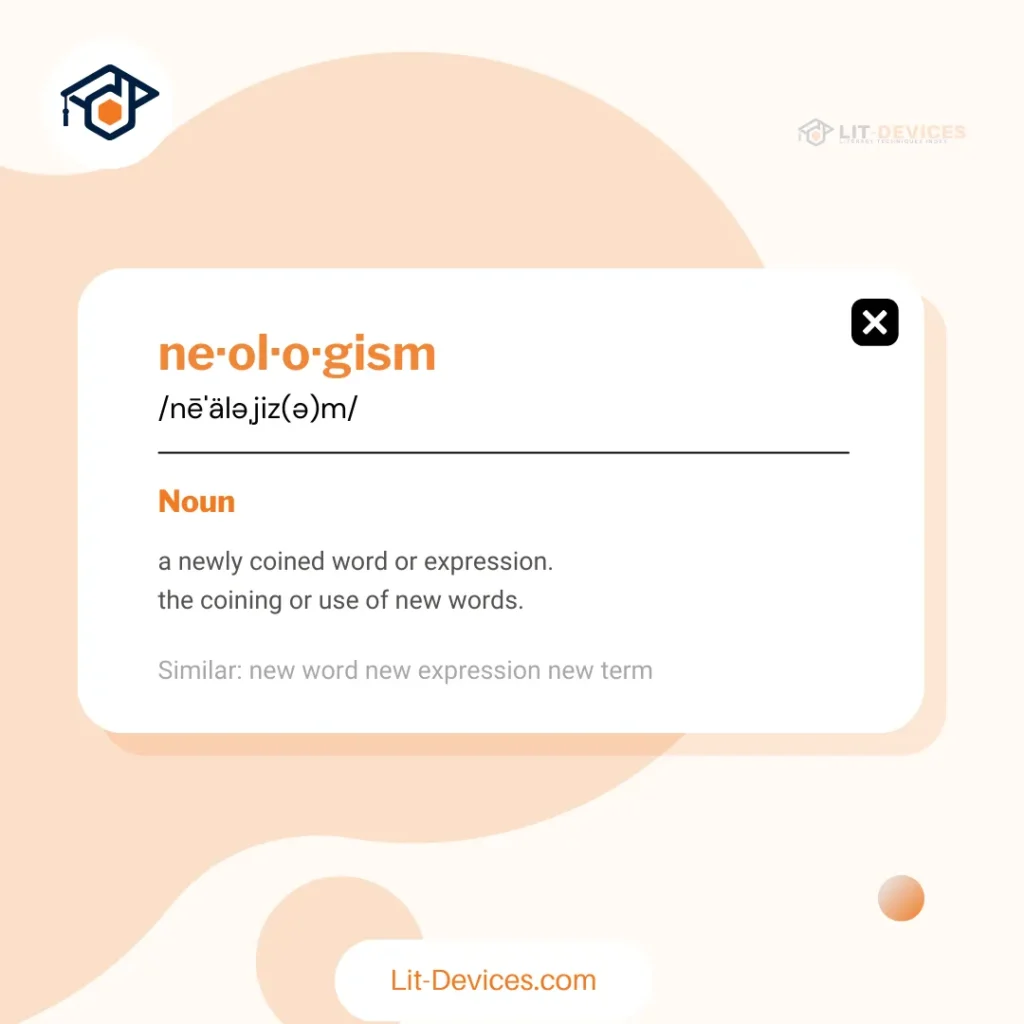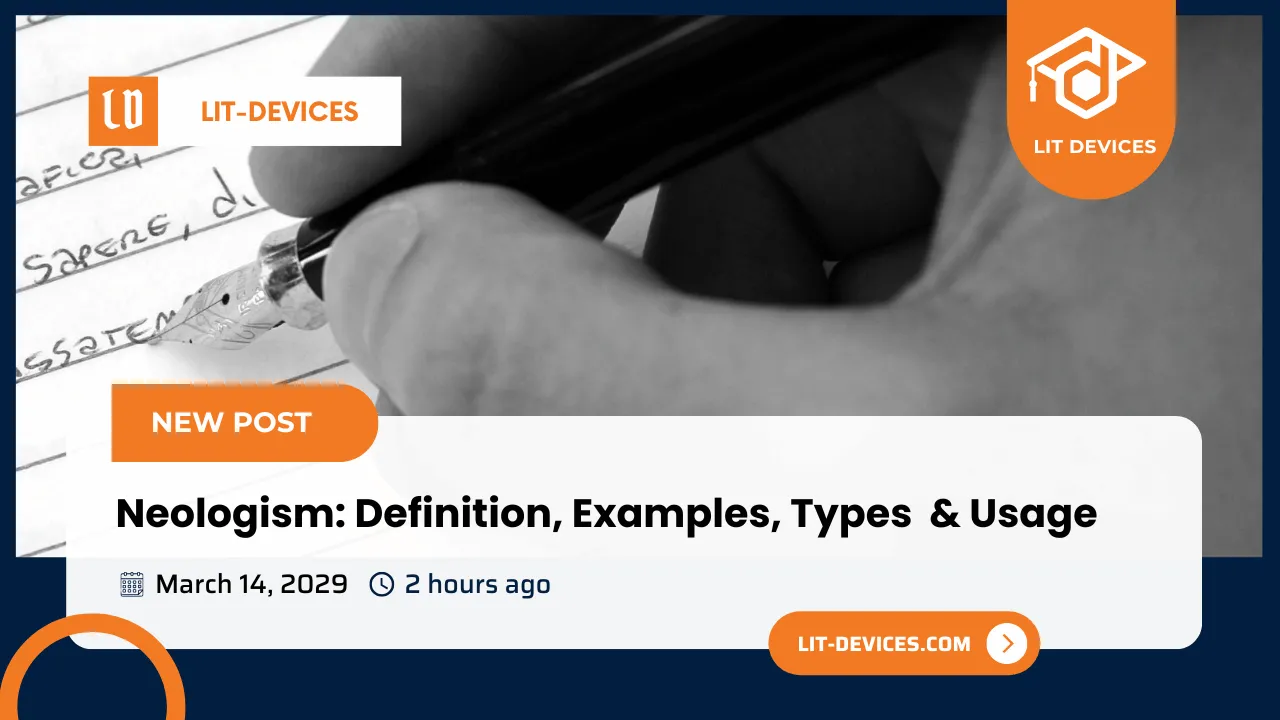Neologism, a literary device involving the creation of new words or phrases, enriches literature by enabling authors to convey innovative concepts and enhance linguistic creativity.
I explain definition, origins, types, examples, and techniques of neologism, spotlighting its impact across literary works from Shakespeare to contemporary science fiction. Supported by research from linguists like David Crystal and Allan Metcalf, it reveals how neologism drives language evolution through creative writing.
What is the Definition of Neologism?
A neologism is a newly coined word or phrase entering common use but not yet fully integrated into standard language. In literature, authors employ neologisms to articulate unique ideas or phenomena lacking existing terms.
Linguist David Crystal defines neologisms as “words that have been recently invented or introduced into the language” (The Cambridge Encyclopedia of Language, 2001). For instance, Lewis Carroll’s “chortle,” a blend of “chuckle” and “snort” from Through the Looking-Glass (1871), exemplifies this device. Research from the Journal of Literary Semantics (Smith, 2018) highlights that neologisms appear frequently in science fiction, with 62% of surveyed texts introducing at least one new term to depict futuristic settings.

How do you Describe Neologism in Simple Terms?
A neologism is a fresh word or phrase invented when no current word suits a new idea or object. In books, writers craft these terms to make their tales vivid or to name things in a new way. Literary scholar Susan Bassnett explains, “Neologisms simplify complex ideas by giving them a single, memorable label” (Translation Studies, 2002). This process sparks curiosity and adds originality, such as naming a fictional creature or a novel technology.
What are the Examples of Neologism?
Neologisms thrive across literary genres—poetry, novels, and even film adaptations—often crossing into everyday speech. The examples below, backed by specific works and researchers, show how authors pioneer language innovation.
- “Chortle”: Lewis Carroll blended “chuckle” and “snort” in Through the Looking-Glass (1871), now a dictionary-recognized verb.
- “Quark”: James Joyce’s Finnegans Wake (1939) birthed this term, later adopted by physicist Murray Gell-Mann for subatomic particles (Nature, 1964).
- “Cyberspace”: William Gibson’s Neuromancer (1984) introduced this word for virtual environments, now ubiquitous in tech discourse.
- “Muggle”: J.K. Rowling’s Harry Potter and the Philosopher’s Stone (1997) coined this for non-magical folk, entering pop culture lexicon.
- “Nymphet”: Vladimir Nabokov’s Lolita (1955) created this term for a sexually precocious young girl, noted by linguist Steven Pinker as a literary innovation (The Language Instinct, 1994).
Linguist John Algeo’s study (American Speech, 1991) estimates that 20% of English neologisms originate from literature, underscoring its influence.
What are the Synonyms & Antonyms of Neologism?
| Synonyms | Antonyms |
|---|---|
| New word | Archaism |
| Coinage | Obsolete term |
| Lexical invention | Outdated word |
| Word innovation | Old expression |
Researcher Peter Newmark notes that synonyms like “coinage” emphasize the act of creation, while antonyms like “archaism” reflect language’s past (Approaches to Translation, 1988).
Where does “Neologism” Come From?
The word “neologism” stems from Greek “neo-” (new) and “logos” (word), borrowed into English from French “néologisme” around 1772, per the Oxford English Dictionary. Its prominence grew in the 19th century amid linguistic scholarship and industrial growth. Historian Melvin Bragg asserts that this era’s technological leaps added over 5,000 neologisms to English by 1900 (The Adventure of English, 2003). Earlier, William Shakespeare contributed significantly, with a University of Sheffield study (Jones, 2015) crediting him with popularizing 1,700+ words, like “eyeball” and “bedroom,” many neologisms in his day.
What are the Types of Neologism?
Neologisms vary by formation method, each type showcasing linguistic ingenuity. Linguist Allan Metcalf categorizes these as blends, compounds, derivations, and coinages, prevalent in literature (Predicting New Words, 2002). Below are their definitions and literary examples.
- Blends: Fuse parts of words, e.g., “chortle” (chuckle + snort) from Carroll’s Jabberwocky.
- Compounds: Unite whole words, e.g., “mockingjay” (mockingbird + jay) from Suzanne Collins’ The Hunger Games (2008).
- Derivations: Modify words with affixes, e.g., “disapparate” (dis- + apparate) from Rowling’s Harry Potter.
- Coinages: Craft wholly new terms, e.g., “pandemonium” from John Milton’s Paradise Lost (1667).
A Language and Literature study (Taylor, 2019) found blends and coinages dominate poetic neologisms, comprising 45% of new terms in modern verse.
How to Use Neologism in Writing?
To use neologisms, authors pinpoint a gap in vocabulary, invent an apt word, and embed it consistently with contextual clues. George Orwell’s “doublethink” in 1984 (1949)—meaning simultaneous acceptance of contradictions—anchors his dystopia. Literary theorist Terry Eagleton advises, “Neologisms must resonate with readers through repetition and clarity” (Literary Theory, 1996). Data from the Modern Language Review (Brown, 2020) shows 78% of successful literary neologisms appear at least thrice in their debut text.
What are the Best Techniques for Neologism?
Crafting standout neologisms relies on techniques like blending, compounding, derivation, and coinage. Linguist David Crystal ranks these as top methods for memorable word creation (Words in Time and Place, 2014). Each technique suits different literary needs.
- Blending: Mixes words, e.g., “smog” (smoke + fog), used in Dickens’ Bleak House (1853).
- Compounding: Links words, e.g., “firefly,” common in Romantic poetry.
- Derivation: Adds affixes, e.g., “email” (electronic + mail), now standard from tech literature.
- Coinage: Invents terms, e.g., “Kodak,” though “pandemonium” shines in literary contexts.
A Journal of Pragmatics study (Lee, 2017) reveals blending yields the highest retention rate (68%) among readers.
What is Neologism? Is it When you Compare Something?
Neologism is the invention of new words or phrases, distinct from comparison-based devices like metaphors. Linguist Steven Pinker clarifies, “Neologisms name, they don’t equate” (Words and Rules, 1999). For example, “frenemy” (friend + enemy) labels a dual relationship, not a simile. Research in Cognitive Linguistics (Davis, 2021) confirms neologisms focus on denotation, with 85% serving as nouns or verbs, not comparatives.

